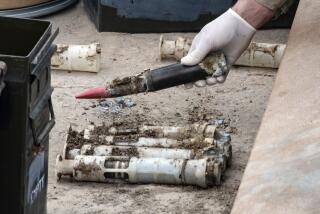Tracking the Tragedies
- Share via
1948--Furiously driven by Lavrenty P. Beria, head of the secret police, the Soviet Union’s crash program to build an atomic bomb scores its first real success when production of radioactive isotopes starts in a secret complex near the Ural Mountains city of Chelyabinsk.
Aug. 29, 1949--Test of the first Soviet nuclear weapon (nicknamed by the Americans “Joe One”--after Josef Stalin) at Semipalatinsk in Kazakhstan. Fallout is carried by winds into neighboring Altai territory of Russia.
1949--Plutonium-producing plant at the Mayak complex near Chelyabinsk begins dumping highly radioactive waste into the Techa river. Through 1956, about 2.75 million curies of waste are flushed into the river, but nearby residents receive no alert.
Aug. 18, 1953--Soviets explode the world’s first hydrogen bomb, built under the guidance of Andrei D. Sakharov, in a demonstration of destructive prowess that awes and frightens the West.
1954--Soviet soldiers and military equipment are tested for their ability to withstand a nuclear explosion in a blast in Kazakhstan.
1954--World’s first commercial nuclear power plant hums into life at Obninsk, not far from Moscow.
Sept. 29, 1957--A load of highly radioactive waste explodes at the Mayak complex, sending a plume of fallout packing 2 million curies of radioactivity into the air over the southern Urals.
July 4, 1961--Reactor emergency on the first Soviet nuclear missile submarine, the K-19. Nine crew members die from radiation exposure.
1961--First documented cases of dumping of liquid radioactive waste into the Barents Sea by Soviet navy vessels.
Oct. 30, 1961--In the air over Novaya Zemlya, an archipelago off northern Russia, the Soviets explode the most powerful weapon in history--a thermonuclear bomb with a yield equivalent to 58 million tons of TNT.
Jan. 15, 1965--First Soviet underground “peaceful nuclear explosion,” at an oil well in Bashkiria. Through 1989, 115 such explosions are carried out across the Soviet Union, leaving at least 100 million curies of radiation in the earth.
1964-65--In the Gulf of Abrosimov off Novaya Zemlya, eight naval reactors are dumped in the sea, including three with the radioactive fuel still intact.
May 24, 1968--A serious accident aboard an experimental nuclear sub, the K-27, kills five crew members; the rest are hospitalized. After lengthy repair attempts, the sub is scuttled near Novaya Zemlya, along with its nuclear fuel.
April 14, 1970--Soviet nuclear sub K-8 sinks in the Bay of Biscay, killing the captain and 52 crewmen.
Sept. 16, 1979--In another “peaceful” explosion, Soviet scientists detonate a nuclear bomb at a Ukrainian coal mine in an attempt to clear it of explosive methane gas. Unknowing miners are sent back down the shaft the next day.
April 26, 1986--Explosion and fire destroy the No. 4 reactor of the Chernobyl Atomic Power Station in Ukraine. Thirty-two people are killed in the immediate aftermath, with total deaths to date caused by radiation put as high as 10,000.
April 7, 1989--42 crewmen die when the nuclear sub “Komsomolets” sinks in the Norwegian Sea, leaving the sub’s reactor and nuclear warheads 300 miles off Norway.
Oct. 19, 1989--343rd and final underground nuclear explosion at the Semipalatinsk site in Kazakhstan. Official statistics cite a total of 467 tests of all types at Semipalatinsk.
March 24, 1992--A Chernobyl-type reactor leaks radioactive gases and iodine into the air at Sosnovy Bor west of St. Petersburg, sparking worldwide concern over the safety of aging reactors in the nations of the former Soviet Bloc.
More to Read
Sign up for Essential California
The most important California stories and recommendations in your inbox every morning.
You may occasionally receive promotional content from the Los Angeles Times.












